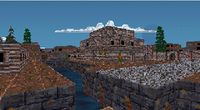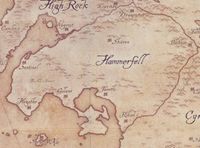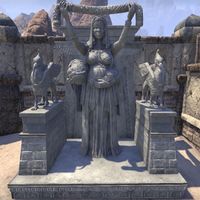Lore:Hegathe
| Hegathe | |
|---|---|
| Type | Settlement |
| Continent | Tamriel |
| Province | Hammerfell |
| Appears in | Arena |
Hegathe (also called Old Hegathe)[1] is one of the eight major cities in the province of Hammerfell,[2] found in the fertile grasslands on the tropical western shore landings of the Abecean Sea.[3][1][4] Hegathe was once the capital of Hammerfell, ever since the Ra Gada landed on its shores in 1E 808 until it was moved to the north, in the Kingdom of Sentinel. It is known for its austere ramparts that harken back to antiquity, and is considered an equal to Wayrest in terms of splendor.[1][UOL 1] The name originally referred to the wastelands that was later designated as Hammerfell, deriving from the Aldmeri word for "Deathland".[5] Despite the meaning of the name, the entire peninsula that the city itself is found upon is a lush subtropical rainforest biome, reaching as far north as Abibon-Gora and as far east as Khefrem.[3][6]
Layout and Geography[edit]
Hegathe is found on the on the south-westernmost point of the mainland of the province, where the coasts are fertile grasslands, and the peninsula itself is a subtropical rainforest.[1][3] There is an island off the coastline of the city.[7] Like other traditional cities in Hammerfell, it is built atop of old ruins of past civilizations, replaced with high domes and flying dew sails that are well-suited for the harsh environment.[5] It also has an impenetrable defense of an antique splendor.[1] It is a city of contrasts with tall, plain stone ramparts found side-by-side with beautiful gold-engraved tents, and a busy modern harbor found near the calm ancient shrines.[UOL 1] One of the city's most iconic landmarks is the Shrine of Tava, a place of veneration for both the Crowns and the Forebears. It is highlighted by the Fresco of the Goshawk, a mural depicting Tava nestled together with his mates, which was meant to symbolize the union of the two factions.[8] Thanks to its coastal plains environment, the city has vineyards where they make their signature wine.[9] Hegathe Lemon Kaveh is also a traditional drink named for the city.[10] Hegathe is neighbored by several settlements, including Kelps Yat to the north and Gilane to the east.[2]
Notable Locales[edit]
History[edit]
Early History[edit]
The name dates farther back than the city itself, or even the Yokudan incursion that swept across the land. It referred to the vast desert found between Colovia and the Iliac Bay, which in Aldmeris is translated to the Deathland. The Tamrielic variant of the word, often used by the Nedes, was the name used for the region of Hammerfell.[5]
When the Ra Gada crossed the Sea of Pearls to eventually reach Tamriel, they landed on the harborage that became Hegathe. It was occupied by the beastfolk, who the Yokudans quickly displaced. It soon became the staging ground for the Ra Gada movement across the coastline. One of these waves was led by Yaghoub, who traveled north along Cape Shira and was the first of the Redguards to discover the Iliac Bay and land on Sentinel.[15] As the remaining refugees had left Herne to populate the mainland, the Yokudan government, the Na-Totambu became fully-integrated and made Hegathe its capital.[1]
In 1E 2200, the Thrassian Plague broke out and it first appeared on mainland Tamrielic soil through major port cities on the southwest coast. Hegathe was the disease's point of entry in Hammerfell and it caused a significant decrease in the population.[16] Many people at the time searched for a cure in vain and unsung heroes like Mazazim al-Hegathe died on their quest.[17] When Mount Firesong erupted over in the Systres in 1E 2484, Hegathe experienced vibrations from the seismic force of the volcano.[18]
Years later when the province of Hammerfell was annexed into the Second Empire, two political parties were formed to contribute to Cyrodiil's administration over the land. The Crowns were created from what was left of the Na-Totambu, who retained their high-ranking status in the Empire and used Hegathe as their capital. From there, they were represented by the Phyllocid Dynasty, who maintained their relationship with the Empire throughout its lifetime. The Forebears was the other political party founded in Hammerfell, from the warrior-lords that descended from the Ra Gada and governed tribal districts in the south. For the longest time, these groups were sworn enemies that exceeded far longer than the Empire itself.[1]
Ar-Azal's reign and onward[edit]
It took the ascension of High King Ar-Azal and his union with the Crowns daughter, Arlimahera and the Forebears daughter, Fereshtah, to break the divide between them.[8] The Osseous Crux was discovered on the shores of the Abecean Sea near Hegathe. It was constructed from the bones of some enormous, unknown beast, bound together with twisted fibrous cords. It was later relocated to Sentinel.[4]
By the Interregnum, the political duality had reverted back to the monarchy of the Na-Totambu and created political unrest, especially when the capital moved from Old Hegathe to the Forebears city of Sentinel. The line of High Kings that ruled from Sentinel continued with Thassad II as the conquests of Tiber Septim continued to expand and enroach on his domain. The High King passed away in 2E 862 and the capital was retaken by the Forebears under the command of Baron Volag, ensuing a vicious civil war between the Crowns and Forebears. When the latter enlisted the help of the Third Empire, victory shifted from the Crowns to the Empire, and eventually, the Crowns lost their territories until Stros M'Kai was left. Both factions reconciled a year later to formally establish the Imperial Province of Hammerfell. Sentinel, however, remained as its provincial capital.[1][19]
During their rule under the Empire, Hegathe became a major trading port with Summerset to the south.[UOL 1] During the Imperial Simulacrum in the late-Third Era, the city-state of Hegathe was an active settlement. It was ruled by Queen Ghapimti and it had a rivalry with Gilane and Sentinel.[12]
In the late-second century, the Great War enveloped Cyrodiil and Hammerfell in total warfare. By 4E 172, the Aldmeri Dominion had moved across Hammerfell's southern coast, leaving Hegathe as one of the remaining cities until in early-4E 173 when the Forebears from Sentinel arrived and broke the siege over the city. The victory over Hegathe brought the reconciliation of the two parties.[20]
Known Rulers[edit]
- The Second Era
- The Third Era
Gallery[edit]
Notes[edit]
- Arena was originally conceived as a fighting game featuring a tournament that took the player to each of Tamriel's cities to challenge different gladiatorial teams. According to a file from that stage of development left behind in the final game, Hegathe's gladiatorial team would have been called "the Bloodhorns".[UOL 2]
See Also[edit]
- For game-specific information, see the Arena article.
References[edit]
- ^ a b c d e f g h Pocket Guide to the Empire, 1st Edition: Hammerfell — Imperial Geographical Society, 2E 864
- ^ a b Map of Hammerfell – The Elder Scrolls: Arena
- ^ a b c Arena terrain map
- ^ a b The Vanishing Crux — Masura-dra, Sentinel Magister
- ^ a b c Pocket Guide to the Empire, 3rd Edition: The Ra Gada: Hammerfell — Imperial Geographical Society, 3E 432
- ^ Climate map of Illiac Bay
- ^ Map of Hammerfell – The Elder Scrolls Anthology
- ^ a b c d e f g h The Worthy Ar-Azal, His Deeds
- ^ Sherveen's dialogue in ESO
- ^ Old Hegathe Lemon Kaveh drink item
- ^ Sacrilege and Mayhem in the Alik'r — Doctor Tazhim of the Bureau of Outlander Affairs
- ^ a b c d Hegathe location and rumors in Arena
- ^ Monarch Hairpin description
- ^ 2920, Sun's Height — Carlovac Townway
- ^ Sentinel, the Jewel of Alik'r — The Unveiled Azadiyeh, Songbird of Satakalaam
- ^ 1. The Thrassian Plague
- ^ Systres History: Volume 3 — Trilam Heladren, Associate Dean of Eltheric History, University of Gwylim
- ^ Systres History: Volume 4 — Trilam Heladren, Associate Dean of Eltheric History, University of Gwylim
- ^ Introduction text in Redguard
- ^ The Great War — Legate Justianus Quintius
- ^ The Brothers of Darkness — Pellarne Assi
Note: The following references are considered to be unofficial sources. They are included to round off this article and may not be authoritative or conclusive.
- ^ a b c Games and Pastimes of Tamriel v. 3 — Taenarus Valius
- ^ Original TES: Arena texts at the Imperial Library







